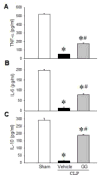Therapeutic effect of human ghrelin and growth hormone: Attenuation of immunosuppression in septic aged rats
- PMID: 28115288
- PMCID: PMC5519455
- DOI: 10.1016/j.bbadis.2017.01.014
Therapeutic effect of human ghrelin and growth hormone: Attenuation of immunosuppression in septic aged rats
Abstract
Sepsis is a leading cause of mortality in intensive care units, and is more common in the geriatric population. The control of hyperinflammation has been suggested as a therapeutic approach in sepsis, but to date clinical trials utilizing this strategy have not lead to an effective treatment. In addition to hyperinflammation, patients with sepsis often experience a state of immunosuppression, which serves as an important determinant for increased morbidity and mortality. We previously used aged animals to demonstrate the effectiveness of combined treatment with human ghrelin (Ghr) and human growth hormone (GH) in improving organ injury and survival in septic animals. Here, we hypothesized that combined treatment with Ghr and GH could improve immune function in septic aged animals. Male 24-month-old rats were subjected to cecal ligation and puncture (CLP) for sepsis induction. Human Ghr (80nmol/kg BW) plus GH (50μg/kg BW) or vehicle (normal saline) was administrated subcutaneously at 5h after CLP. The ex vivo production of TNF-α, IL-6 and IL-10 to LPS-stimulation, as well as TNF-α, IL-6, IL-10 and IFN-γ production to anti-CD3/anti-CD28 antibody-stimulation, in splenocytes isolated 20h after CLP, was significantly decreased compared to production of these cytokines in splenocytes from sham animals. The production of cytokines from splenocytes isolated from septic animals that received the combined treatment, however, was significantly higher than from those isolated from vehicle-treated septic animals. Combined treatment prevented the loss of splenic CD4+ and CD8+ T cells in septic aged rats, and reduced lymphocyte apoptosis. Combined treatment also inhibited an increase in the regulatory T cell (Treg) population and expression of the immune co-inhibitory molecule PD-1 in the spleens of septic aged rats. In contrast, expression of HLA-DR was increased after combined treatment with Ghr and GH. Based on these findings, we conclude that co-administration of Ghr and GH is a promising therapeutic tool for reversing immunosuppression caused by sepsis in the geriatric population. This article is part of a Special Issue entitled: Immune and Metabolic Alterations in Trauma and Sepsis edited by Dr. Raghavan Raju.
Keywords: Aging; Ghrelin; Growth hormone; Immunosuppression; Sepsis.
Copyright © 2017 Elsevier B.V. All rights reserved.
Conflict of interest statement
PW is the inventor of the United States Patent No. US 8,324,151 B2: “Treatment of sepsis and septic shock using ghrelin and growth hormone.” TheraSource, LLC holds the exclusive option to license the technology from the Feinstein Institute for Medical Research. PW is a cofounder of TheraSource, LLC. Other authors declare that they have no competing interests.
Figures








References
-
- Gustot T. Multiple organ failure in sepsis: prognosis and role of systemic inflammatory response. Curr Opin Crit Care. 2011;17:153–159. - PubMed
-
- Dombrovskiy VY, Martin AA, Sunderram J, Paz HL. Rapid increase in hospitalization and mortality rates for severe sepsis in the United States: a trend analysis from 1993 to 2003. Crit Care Med. 2007;35:1244–1250. - PubMed
-
- Dinarello CA. Anti-cytokine therapies in response to systemic infection. J Investig Dermatol Symp Proc. 2001;6:244–250. - PubMed
-
- Minnich DJ, Moldawer LL. Anti-cytokine and anti-inflammatory therapies for the treatment of severe sepsis: progress and pitfalls. Proc Nutr Soc. 2004;63:437–441. - PubMed
Publication types
MeSH terms
Substances
Grants and funding
LinkOut - more resources
Full Text Sources
Other Literature Sources
Medical
Research Materials
Miscellaneous

